Mount Warning’s ancient name is Wollumbin, which means ‘Cloud Catcher’, and is the core of the largest extinct shield volcano in the Southern Hemisphere. It’s also the first part of mainland Australia to be touched each day by the sun. Mount Warning is steeped in local history and revered in ancient stories by the local Bundjalung people.
The Mount Warning National Park is 20 minutes from Murwillumbah in northern NSW and 2 hours south of Brisbane along the Pacific Highway. The bypass highway has reduced the through traffic and Murwillumbah is now, unfortunately, seen as a diversion along the road to Ballina and all points south.
The drive to the mountain is on a sealed road, which is tight in spots, and finishes in a car park. I recommend arriving here around 8.00am to secure a parking space so as to avoid parking on the side of the road. It’s advisable to use the toilet facilities here before going any further as the track is well-travelled.
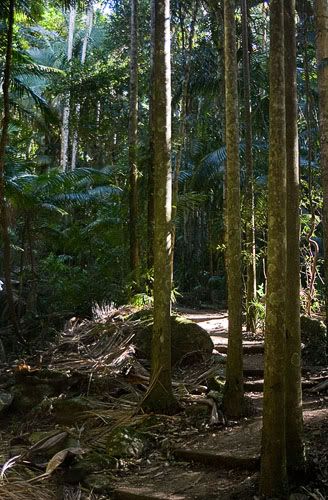
Those steps
Photo: © Malcolm Daughtree
Each step along the 4.5 kilometre track to the summit of Mount Warning is upwards and presents a real challenge for the unprepared. The walk commences with a lovely manicured path and steps, which tends to lull you into a sense of the achievable. The designer of these steps was seemingly a torturer in a previous life, and after more than 1000 weirdly spaced steps you may begin to wonder why you decided to submit yourself to all this pain. Well, I’m exaggerating a little, but it will awaken your long dormant muscles. The walk through the lower section is rainforest and mountain streams, and first thing in the morning is wonderfully cool – even in summer.
Once you have limbered-up on the stairs, and pushed through the burning pain you have come to associate in your lower legs, you can begin to enjoy the climb. Some parts are easy as they are on reasonably wide tracks, but some sections are more precarious where you’ll have to navigate a couple of rocky outcrops.
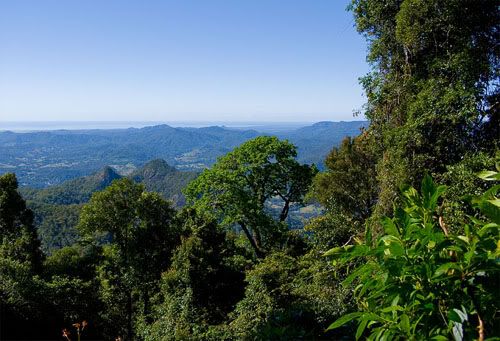
View half way up
Photo: © Malcolm Daughtree
Half way up the switchback patterned track there is a sign that advises if you are going up and the time is 1:00pm, then you shouldn’t proceed to the summit. Some disregard the warning and run the risk of serious injury in the failing evening light. But, if you are like us, it should be about 9:00am by the time you reach the half way point. From here it is 2.3 kilometres up and 2.2 kilometres down – so, there’s no stopping and turning back!
Thankfully the upper section of the walk has a few well-placed benches where you can sit and recover, although sitting for too long may make it a little tougher to get moving again. As the track continues, there is an occasional break in the canopy which offers wonderful views of the country you are walking through. The path finally comes to an end with a welcome bench. However, this is where many people seem to second guess themselves and wonder why they are taking on such a challenge – you have reached the chain climb.
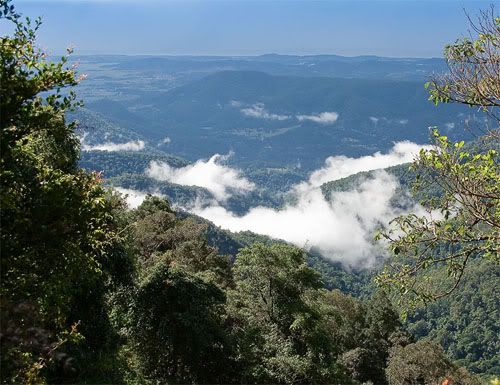
Through the trees
Photo: © Malcolm Daughtree
Some words of caution. If it has been raining on the way up, the rocks can be very slippery. I recommend those not confident in their ability or not experienced rock scramblers to consider not proceeding any further. The climb is about 150 metres of chain-assisted rock scrambling and it can be dangerous. Some sections are as steep as 45-50 degrees, and others are over bare rock with toe and hand holds carved into the rock face. If you follow the rule of three points of contact at all times, you should be fine.
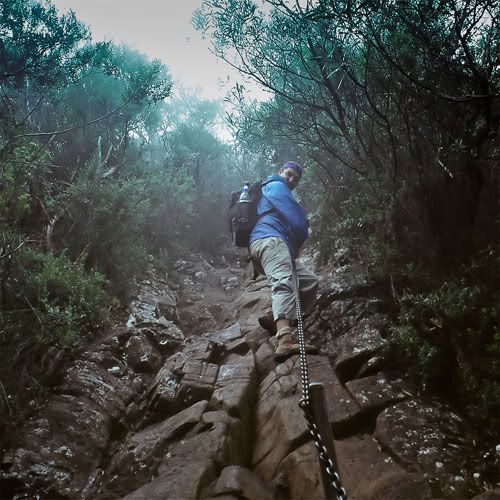
Chain climb
Photo: © Malcolm Daughtree
The chain seems to go on forever, but soon there’s relief and the reward of an uninterrupted view at the summit from three decks. You can look north to the Gold Coast, east to Point Byron, west to the MacPherson Ranges and south to where you can take in the grandeur of the Tweed Volcano. If you arrive here by 10:30am you have done well. The lighting conditions should still be kind for some lovely photographs.
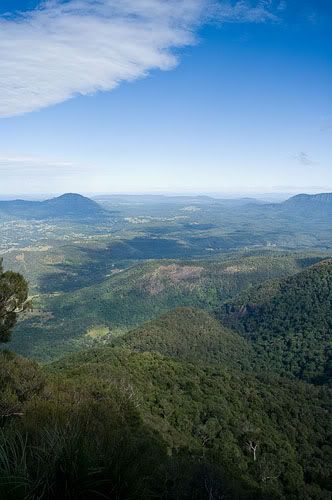
From the top looking south-west
Photo: © Malcolm Daughtree
If the view from the top is obscured by clouds, stay awhile and enjoy the feeling of your accomplishment. If nothing else, I suggest you take time to recover for the 4.5 kilometre return trip.
No comments:
Post a Comment
Welcome to Discover Australia magazine.
Your comments and feedback are welcome.